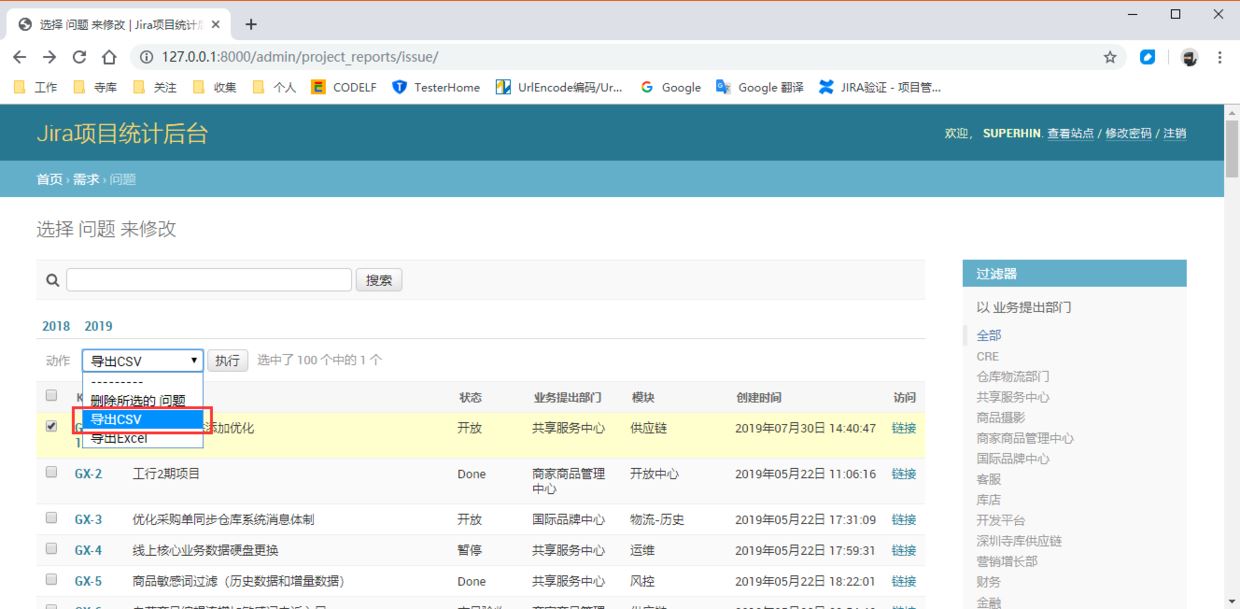Python fileinput模块使用实例
fileinput模块可以对一个或多个文件中的内容进行迭代、遍历等操作。
该模块的input()函数有点类似文件readlines()方法,区别在于:
前者是一个迭代对象,即每次只生成一行,需要用for循环迭代。
后者是一次性读取所有行。在碰到大文件的读取时,前者无疑效率更高效。
用fileinput对文件进行循环遍历,格式化输出,查找、替换等操作,非常方便。
【典型用法】
import fileinput
for line in fileinput.input():
process(line)
【基本格式】
fileinput.input([files[, inplace[, backup[, bufsize[, mode[, openhook]]]]]])
【默认格式】
fileinput.input (files=None, inplace=False, backup='', bufsize=0, mode='r', openhook=None)
files: #文件的路径列表,默认是stdin方式,多文件['1.txt','2.txt',...]
inplace: #是否将标准输出的结果写回文件,默认不取代
backup: #备份文件的扩展名,只指定扩展名,如.bak。如果该文件的备份文件已存在,则会自动覆盖。
bufsize: #缓冲区大小,默认为0,如果文件很大,可以修改此参数,一般默认即可
mode: #读写模式,默认为只读
openhook: #该钩子用于控制打开的所有文件,比如说编码方式等;
【常用函数】
fileinput.input() #返回能够用于for循环遍历的对象
fileinput.filename() #返回当前文件的名称
fileinput.lineno() #返回当前已经读取的行的数量(或者序号)
fileinput.filelineno() #返回当前读取的行的行号
fileinput.isfirstline() #检查当前行是否是文件的第一行
fileinput.isstdin() #判断最后一行是否从stdin中读取
fileinput.close() #关闭队列
【常见例子】
例子01: 利用fileinput读取一个文件所有行
>>> import fileinput
>>> for line in fileinput.input('data.txt'):
print line,
#输出结果
Python
Java
C/C++
Shell
命令行方式:
#test.py
import fileinput
for line in fileinput.input():
print fileinput.filename(),'|','Line Number:',fileinput.lineno(),'|: ',line
c:>python test.py data.txt
data.txt | Line Number: 1 |: Python
data.txt | Line Number: 2 |: Java
data.txt | Line Number: 3 |: C/C++
data.txt | Line Number: 4 |: Shell
例子02: 利用fileinput对多文件操作,并原地修改内容
#test.py
#---样本文件---
c:\Python27>type 1.txt
first
second
c:\Python27>type 2.txt
third
fourth
#---样本文件---
import fileinput
def process(line):
return line.rstrip() + ' line'
for line in fileinput.input(['1.txt','2.txt'],inplace=1):
print process(line)
#---结果输出---
c:\Python27>type 1.txt
first line
second line
c:\Python27>type 2.txt
third line
fourth line
#---结果输出---
命令行方式:
#test.py
import fileinput
def process(line):
return line.rstrip() + ' line'
for line in fileinput.input(inplace = True):
print process(line)
#执行命令
c:\Python27>python test.py 1.txt 2.txt
例子03: 利用fileinput实现文件内容替换,并将原文件作备份
#样本文件:
#data.txt
Python
Java
C/C++
Shell
#FileName: test.py
import fileinput
for line in fileinput.input('data.txt',backup='.bak',inplace=1):
print line.rstrip().replace('Python','Perl') #或者print line.replace('Python','Perl'),
#最后结果:
#data.txt
Python
Java
C/C++
Shell
#并生成:
#data.txt.bak文件
#其效果等同于下面的方式
import fileinput
for line in fileinput.input():
print 'Tag:',line,
#---测试结果:
d:\>python Learn.py < data.txt > data_out.txt
例子04: 利用fileinput将CRLF文件转为LF
import fileinput
import sys
for line in fileinput.input(inplace=True):
#将Windows/DOS格式下的文本文件转为Linux的文件
if line[-2:] == "\r\n":
line = line + "\n"
sys.stdout.write(line)
例子05: 利用fileinput对文件简单处理
#FileName: test.py
import sys
import fileinput
for line in fileinput.input(r'C:\Python27\info.txt'):
sys.stdout.write('=> ')
sys.stdout.write(line)
#输出结果
>>>
=> The Zen of Python, by Tim Peters
=>
=> Beautiful is better than ugly.
=> Explicit is better than implicit.
=> Simple is better than complex.
=> Complex is better than complicated.
=> Flat is better than nested.
=> Sparse is better than dense.
=> Readability counts.
=> Special cases aren't special enough to break the rules.
=> Although practicality beats purity.
=> Errors should never pass silently.
=> Unless explicitly silenced.
=> In the face of ambiguity, refuse the temptation to guess.
=> There should be one-- and preferably only one --obvious way to do it.
=> Although that way may not be obvious at first unless you're Dutch.
=> Now is better than never.
=> Although never is often better than *right* now.
=> If the implementation is hard to explain, it's a bad idea.
=> If the implementation is easy to explain, it may be a good idea.
=> Namespaces are one honking great idea -- let's do more of those!
例子06: 利用fileinput批处理文件
#---测试文件: test.txt test1.txt test2.txt test3.txt---
#---脚本文件: test.py---
import fileinput
import glob
for line in fileinput.input(glob.glob("test*.txt")):
if fileinput.isfirstline():
print '-'*20, 'Reading %s...' % fileinput.filename(), '-'*20
print str(fileinput.lineno()) + ': ' + line.upper(),
#---输出结果:
>>>
-------------------- Reading test.txt... --------------------
1: AAAAA
2: BBBBB
3: CCCCC
4: DDDDD
5: FFFFF
-------------------- Reading test1.txt... --------------------
6: FIRST LINE
7: SECOND LINE
-------------------- Reading test2.txt... --------------------
8: THIRD LINE
9: FOURTH LINE
-------------------- Reading test3.txt... --------------------
10: THIS IS LINE 1
11: THIS IS LINE 2
12: THIS IS LINE 3
13: THIS IS LINE 4
例子07: 利用fileinput及re做日志分析: 提取所有含日期的行
#--样本文件--
aaa
1970-01-01 13:45:30 Error: **** Due to System Disk spacke not enough...
bbb
1970-01-02 10:20:30 Error: **** Due to System Out of Memory...
ccc
#---测试脚本---
import re
import fileinput
import sys
pattern = '\d{4}-\d{2}-\d{2} \d{2}:\d{2}:\d{2}'
for line in fileinput.input('error.log',backup='.bak',inplace=1):
if re.search(pattern,line):
sys.stdout.write("=> ")
sys.stdout.write(line)
#---测试结果---
=> 1970-01-01 13:45:30 Error: **** Due to System Disk spacke not enough...
=> 1970-01-02 10:20:30 Error: **** Due to System Out of Memory...
例子08: 利用fileinput及re做分析: 提取符合条件的电话号码
#---样本文件: phone.txt---
010-110-12345
800-333-1234
010-99999999
05718888888
021-88888888
#---测试脚本: test.py---
import re
import fileinput
pattern = '[010|021]-\d{8}' #提取区号为010或021电话号码,格式:010-12345678
for line in fileinput.input('phone.txt'):
if re.search(pattern,line):
print '=' * 50
print 'Filename:'+ fileinput.filename()+' | Line Number:'+str(fileinput.lineno())+' | '+line,
#---输出结果:---
>>>
==================================================
Filename:phone.txt | Line Number:3 | 010-99999999
==================================================
Filename:phone.txt | Line Number:5 | 021-88888888
>>>
例子09: 利用fileinput实现类似于grep的功能
import sys
import re
import fileinput
pattern= re.compile(sys.argv[1])
for line in fileinput.input(sys.argv[2]):
if pattern.match(line):
print fileinput.filename(), fileinput.filelineno(), line
$ ./test.py import.*re *.py
#查找所有py文件中,含import re字样的
addressBook.py 2 import re
addressBook1.py 10 import re
addressBook2.py 18 import re
test.py 238 import re
例子10: 利用fileinput做正则替换
#---测试样本: input.txt
* [Learning Python](#author:Mark Lutz)
#---测试脚本: test.py
import fileinput
import re
for line in fileinput.input():
line = re.sub(r'\*
(.∗)
#(.*)', r'<h2 id="\2">\1</h2>', line.rstrip())
print(line)
#---输出结果:
c:\Python27>python test.py input.txt
<h2 id="author:Mark Lutz">Learning Python</h2>
例子11: 利用fileinput做正则替换,不同字模块之间的替换
#---测试样本:test.txt
[@!$First]&[*%-Second]&[Third]
#---测试脚本:test.py
import re
import fileinput
regex = re.compile(r'^([^&]*)(&)([^&]*)(&)([^&]*)')
#整行以&分割,要实现[@!$First]与[*%-Second]互换
for line in fileinput.input('test.txt',inplace=1,backup='.bak'):
print regex.sub(r'\3\2\1\4\5',line),
#---输出结果:
[*%-Second]&[@!$First]&[Third]
例子12: 利用fileinput根据argv命令行输入做替换
#---样本数据: host.txt
# localhost is used to configure the loopback interface
# when the system is booting. Do not change this entry.
127.0.0.1 localhost
192.168.100.2 www.test2.com
192.168.100.3 www.test3.com
192.168.100.4 www.test4.com
#---测试脚本: test.py
import sys
import fileinput
source = sys.argv[1]
target = sys.argv[2]
files = sys.argv[3:]
for line in fileinput.input(files,backup='.bak',openhook=fileinput.hook_encoded("gb2312")):
#对打开的文件执行中文字符集编码
line = line.rstrip().replace(source,target)
print line
#---输出结果:
c:\>python test.py 192.168.100 127.0.0 host.txt
#将host文件中,所有192.168.100转换为:127.0.0
127.0.0.1 localhost
127.0.0.2 www.test2.com
127.0.0.3 www.test3.com
127.0.0.4 www.test4.com

